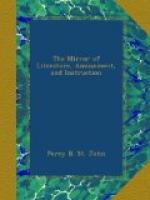We attended the private view of this very attractive exhibition, and were happy to find the galleries filled with distinguished Artists and Patrons of Art. The collection is of a novel character, inasmuch as it associates the works of deceased and living British Artists; though, discouraging as may be the fact, the juxtaposition is not to the advantage of the latter: alas! “that’s true, ’tis pity, and pity ’tis ‘tis true.” Nevertheless, the object of the British Artists’ Society in forming this collection, is laudable in every respect; since “it is evident that an Exhibition of the works of celebrated deceased Masters is calculated to benefit, in an essential degree, the race of living Artists, who will here have an opportunity of carefully inspecting, and deriving instruction from many of those pictorial efforts which are the pride and honour of the British School:” so true is it, in the case of painters, that the good which men do, lives after them. To the public, we mean the sight-craving public, this Exhibition may be of paramount interest: it may perchance modify their admiration of faithless vanity-feeding portraits, and gaudy compositions of vulgar life, full of coarse effect, and painted as less ingenious articles are made, to catch a purchaser.
The Exhibition embraces specimens of the works of nearly seventy deceased Artists, from various collections. Among them are Reynolds, Hogarth, Gainsborough, Morland, Wilson, Fuseli, Zoffani, Blake, Opie, De Loutherbourg, Northcote, Harlow, Jackson, Bonington, Lawrence, &c. &c.; and, as many of the specimens are associated with pleasurable recollections, we will endeavour to notice a few of them, in succession with the works of the living Artists.
1. Alderman Boydell, painted by Muller, and the property of Messrs. Moon, Boys, and Greaves, who, as the successors of the Alderman, retain his portrait as a kind of heirloom in connexion with the best days of British Art.
10. and 12. Duke and Duchess of Leinster. Reynolds. The drawing of the latter is not quite worthy of the President’s fame.
7. Farm Yard and Pigs. Morland. Painted, for aught we know, at the artist’s usual rate, when in confinement, “four-guineas per day with his drink.”
8. Landscape. Gainsborough. Stamped, as Mr. Cunningham says, all Gainsborough’s works are, “with the image of old England.”
9. Sir W. Curtis, Bart. Lawrence. A fine portrait of the City wit: his face is lit up with good nature, such as proved in the Baronet’s career, a surprising foil to the madness of party.
11. Landscape and Cattle. The former by Barrett, the latter by Gilpin. Cunningham calls Barrett “an indifferent dauber;” rather a harsh term in connexion with this picture.
18. Rape of the Lock. A picture of merit, by Henry Wyatt.
21. Death of Oedipus. One of Fuseli’s most tragical creations.




